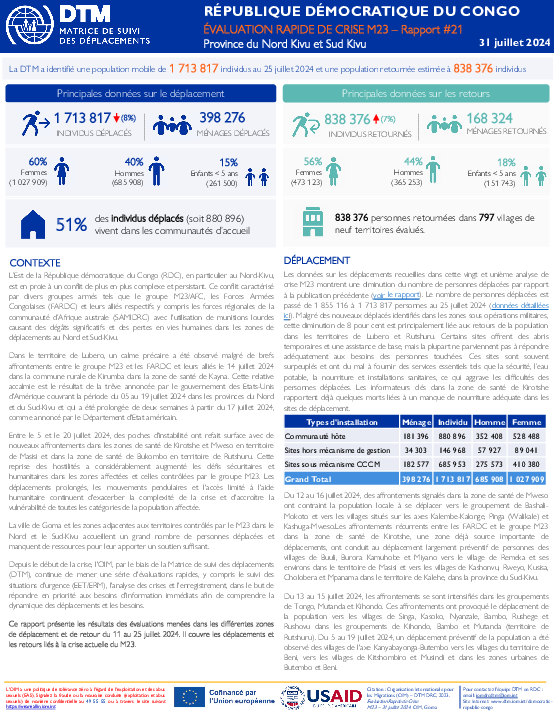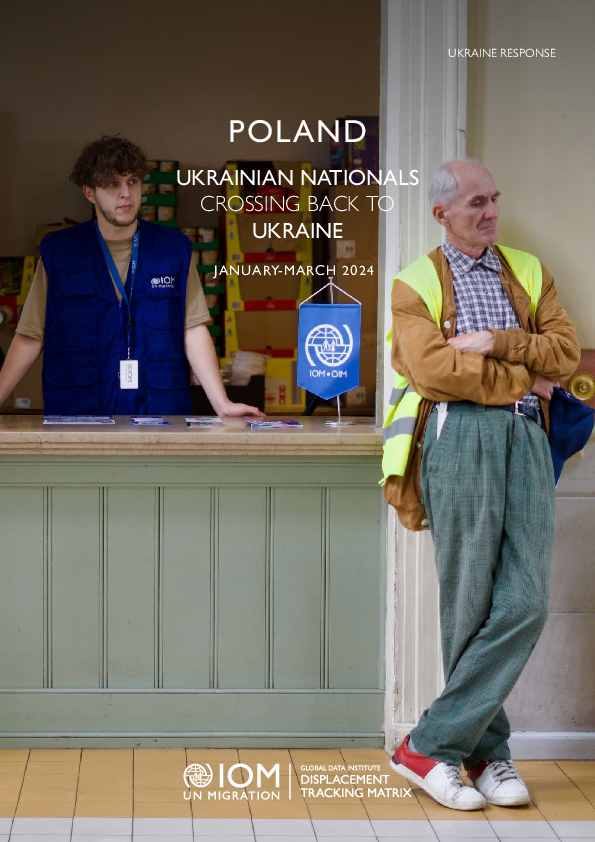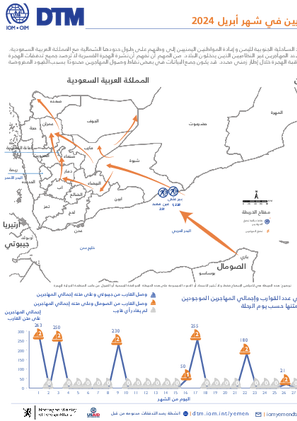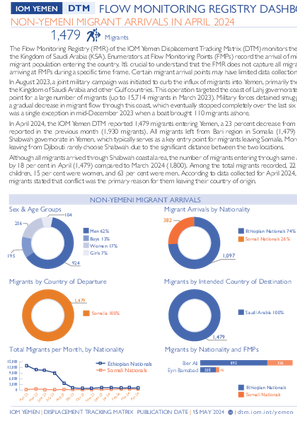-
Countries
-
Data and Analysis
-
Special Focus
-
Crisis Responses
Return migration

Contact
DTM DRC, iomdrcdtm@iom.int
Language
French
Location
Democratic Republic of the Congo
Period Covered
Jul 04 2024
Jul 25 2024
Activity
- Mobility Tracking
- Event Tracking
L’Est de la République démocratique du Congo (RDC), en particulier au Nord-Kivu, est en proie à un conflit de plus en plus complexe et persistant. Ce conflit caractérisé par divers groupes armés tels que le groupe M23/AFC, les Forces Armées Congolaises (FARDC) et leurs alliés respectifs y compris les forces régionales de la communauté d’Afrique australe (SAMIDRC) avec l'utilisation de munitions lourdes causant des dégâts significatifs et des pertes en vies humaines dans les zones de déplacements au Nord et Sud-Kivu.
Dans le territoire de Lubero, un calme précaire a été observé malgré de brefs affrontements entre le groupe M23 et les FARDC et leurs alliés le 14 juillet 2024 dans la commune rurale de Kirumba dans la zone de santé de Kayna. Cette relative accalmie est le résultat de la trêve annoncée par le gouvernement des Etats-Unis d'Amérique couvrant la période du 05 au 19 juillet 2024 dans les provinces du Nord et du Sud-Kivu et qui a été prolongée de deux semaines à partir du 17 juillet 2024, comme annoncé par le Département d'Etat américain.
Entre le 5 et le 20 juillet 2024, des poches d'instabilité ont refait surface avec de nouveaux affrontements dans les zones de santé de Kirotshe et Mweso en territoire de Masisi et dans la zone de santé de Bukombo en territoire de Rutshuru. Cette reprise des hostilités a considérablement augmenté les défis sécuritaires et humanitaires dans les zones affectées et celles contrôlées par le groupe M23. Les déplacements prolongés, les mouvements pendulaires et l'accès limité à l'aide humanitaire continuent d'exacerber la complexité de la crise et d'accroître la vulnérabilité de toutes les catégories de la population affectée.
La ville de Goma et les zones adjacentes aux territoires contrôlés par le M23 dans le Nord et le Sud-Kivu accueillent un grand nombre de personnes déplacées et manquent de ressources pour leur apporter un soutien suffisant.
Depuis le début de la crise, l'OIM, par le biais de la Matrice de suivi des déplacements (DTM), continue de mener une série d'évaluations rapides, y compris le suivi des situations d'urgence (EET/ERM), l'analyse des crises et l'enregistrement, dans le but de répondre en priorité aux besoins d'information immédiats afin de comprendre la dynamique des déplacements et les besoins.
Ce rapport présente les résultats des évaluations menées dans les différentes zones de déplacement et de retour du 11 au 25 juillet 2024. Il couvre les déplacements et les retours liés à la crise actuelle du M23.
This report presents evidence on persons crossing back to Ukraine from abroad distinguishing between those who aim to remain in the country for longer periods and those who plan to pay a short visit. Individuals planning to spend 0 to 30 days in Ukraine are categorized as “short-term visitors,” while those intending to stay longer than one month are identified as “prospective returnees.” The analysis is based on 4,938 surveys collected by DTM between January and March 2024 with adult individuals travelling to Ukraine from the neighbouring countries.
Key Findings:
- Among 4,903 Ukrainians, 92% were women and 8% were men.
- 25% of respondents were prospective returnees, 56% were short-term visitors and 19% were undecided.
- 56% stayed in neighbouring countries prior to crossing back
- Top reasons to cross back included: Meeting family members (53%), receiving medical care (2£%), returning after visiting someone abroad (18%), obtain/renew documents (13%), and reunite with family members (10%).
- 62% of respondents received aid while abroad.
- Top 5 needs included: Financial support (41%), personal safety and security (30%), health services (24%), medicines (19%) and employment (11%).
- For Third Country Nationals (TCNs), 89% left Ukraine because of the war and 83% resided in Ukraine for more than 5 years prior to displacement.

Contact
mtmkyrgyzstan@iom.int
Language
English
Location
Kyrgyzstan
Period Covered
Jan 01 2018
Dec 31 2023
Activity
- Mobility Tracking
Бул баяндама төмөндөгү методология бөлүмүндө түшүндүрүлгөндөй Миграциялык Маалыматтарды Картага түшүрүү боюнча машыгуу иш-чаранын негизги жыйынтыктарын аныктайт, жана Кыргызстандагы миграция жөнүндө азыркы учурда болгон жеткиликтүү маалыматтарды аныктайт. Каралып чыккан миграция маалыматы Кыргызстандагы активдүү жана тиешелүү мамлекеттик маалымат базаларынын, ошондой эле БУУнун агенттиктеринин жана өнүктүрүү мекемелеринин картасын камтыйт. Тактап айтканда, маалыматтарды карап чыгууда иммиграция, эмиграция, кайра кайтып келүү миграциясы, документсиз миграция, Кыргызстанда жашаган качкындар, Кыргызстандан келген качкындар, ички миграция, ири маалымат жана акча которуулар боюнча тематикалык багыттар камтылган. Бул баяндама ошондой эле негизги улуттук миграция саясатын жана тиешелүү кызыкдар тараптарды баса белгилейт.
Кыргыз Республикасындагы иммиграция боюнча учурдагы маалымат туралуу топтомдорун карап чыккандан кийин, иммигранттардын агымы боюнча маалымат мамлекеттик органдар тарабынан жыл сайын чогултулуп, баяндама берилип жатканы такталды. Жыл боюнча бөлүштүрүлгөн иммигранттардын агымынын саны тууралуу маалымат Кыргызстандын Улуттук статистикалык комитетинде (КР УСК) кыргыз, орус жана англис тилдеринде жеткиликтүү. Бирок, иммигранттардын жынысы, билими, туулган жери, жашы жана жумушу боюнча маалыматтын бөлүштүрүлүшү коомго ачык жеткиликтүү эмес, бирок мындай маалыматтарды КР УСКнен расмий маалымат өтүнүчү аркылуу алууга болот. КР УСКсы жана Кыргызстандын Эмгек, ссоциалдык камсыздоо жана миграция министрлиги (КР ЭСКжММ) тарабынан билдирилген иммигранттардын агымы тууралуу маалымат КР УСКки тарабынан билдирилген маалыматтан кыйла айырмаланат, ал дегени ар мекеме тарабынан колдонулган иммигранттардын аныктамалары ар түрдүү болушу мүмкүн дегенди билдирет билдирет. Өлкөдө туруктуу жашап жаткан иммигранттардын саны боюнча так маалымат жок, бирок маалыматты БУУнун Экономикалык жана Cоциалдык иштер департаментинин маалымат платформасынан табууга мүмкүнчүлүк бар. Келечектеги изилдөөлөр өлкөдөгү туруктуу жашап жаткан иммигранттардын санын аныктоого багытталышы керек.
Башка өлкөлөргө Кыргызстан жарандарынын эмиграцияга кетуу тууралуу маалыматтарды талдоо көрсөткөндөй, эмиграциялык агымдар жөнүндө маалыматтардын көпчүлүгү административдик маалыматтардын негизинде түзүлөт. КР УСКсы жыл сайын өзүнүн веб-баракчасында эмигранттардын агымы жөнүндө баяндама маалыматтарды берип турат, анда эмигранттар этностук таандыктыгы, жынысы, жаш курагы, өз өлкөсүндө келип чыккан жери жана барган өлкөсү боюнча маалыматтар менен бөлүшөт. Бул маалымат жалпы коомчулукка ачык, негизинен орус тилинде жеткиликтүү. Кыргызстандын чет өлкөдөгү дипломатиялык өкүлчүлүктөрү жана консулдук мекемелери да эмигранттарды каттоого, маалыматтарды чогултууга жана эмигранттардын болжолдуу саны жөнүндө баяндама берүүгө катышат. Бирок, эмигранттардын социалдык профили тууралуу маалымат жок. Өнүгүү уюмдары тарабынан жүргүзүлгөн ар кандай сурамжылоолор жана изилдөөлөр эмигранттардын социалдык профили жөнүндө маалымат берет, бирок бул изилдөөлөрдүн ар биринин өз чектөөлөрү бар. Кийинки изилдөөлөр административдик маалыматтардын негизинде алынган мигранттардын саны жөнүндө маалыматка багытталышы керек.

Contact
mtmkyrgyzstan@iom.int
Language
English
Location
Kyrgyzstan
Period Covered
Jan 01 2018
Dec 31 2023
Activity
- Mobility Tracking
This report summarizes the key findings of the Migration Data Mapping Exercise, as explained in the methodology section below, and identifies existing and available migration data in Kyrgyzstan. The reviewed migration data includes a mapping of active and relevant government databases as well as UN Agencies and development actors in Kyrgyzstan. Specifically, the data review captured thematic areas on immigration, emigration, return migration, undocumented migration, refugees hosted in Kyrgyzstan, refugees from Kyrgyzstan, internal displacement, internal migration, big data, and remittances. The report also highlights key national migration policies and stakeholders.
After reviewing existing datasets on immigration to Kyrgyzstan, it was found that data on the flow of immigrants is collected and reported annually by government agencies. Data on the number of immigrant flow distributed by year is available at the National Statistics Committee of Kyrgyzstan (NSC KR) in Kyrgyz, Russian, and English. However, data breakdowns by immigrants’ gender, education, place of origin, age, and employment is not available publicly but can be obtained through formal data request from NSC KR. Data on the flow of immigrants reported by NSC KR and the Ministry of Labour, Social Security, and Migration of Kyrgyzstan (MoLSSM KR) significantly differs from the data reported by NSC KR because of different definitions of immigrants used by different agencies. Data on the number of stock of immigrants is missing in the country but can be found on the UN DESA data platform. Further research should focus on the stock of immigrants in the country.
The data review on the emigration of Kyrgyz citizens to other countries revealed that most of the emigration outflow data is generated from administrative data. NSC KR reports on the outflow of emigrants annually on its website with data breakdowns such as emigrants by ethnicity, gender, age group, place of origin in home country, and by country of destination. These data are publicly accessible, mostly in the Rus-sian language. Diplomatic missions and consular offices of Kyrgyzstan in foreign countries are also involved in registration, data collection, and reporting on the estimated emigrants’ stock. However, information on the social profile of emigrants’ stock is missing. Different surveys and studies implemented by different de-velopment actors provide information on the social profile data of emigrants, but each of these studies has its own limitations. Further research should focus on the stock data of emigrants generated from adminis-trative data.

Contact
DTM Europe, DTMMediterranean@iom.int
Language
English
Location
Republic of Moldova
Period Covered
Jan 01 2024
Mar 31 2024
Activity
- Survey
- Return Intention
- Flow Monitoring
IOM’s Displacement Tracking Matrix (DTM) collects data on Ukrainian nationals and Third-Country Nationals (TCNs) that were crossing back to Ukraine from or through the Republic of Moldova, either for temporary stay or prospective return. The survey focuses on the return intentions, duration of displacement, destinations, assistance, and experiences of unequal treatment of the respondents. A total of 1,800 surveys were collected between January and March 2024.
Key findings:
- 87% of Ukrainian respondents planned to go for a short visit, 7% intended to stay in Ukraine (prospective returnees), while 6% were not sure about their intentions.
- The majority (69%) been residing in the Republic of Moldova, 9% in Romania, 5% in Germany. The remaining 17% stayed in other countries.
- 83% were going back to their Oblast of origin, while 17% were going back to a different Oblast.
- 43% had been displaced between January and June 2022.
- 67% crossed back to Ukraine twice or more since 2022. 10% crossed more than 10 times.
- 79% of prospective returnees and 91% of short-term visitors reported having received assistance since their displacement.
- Main priority needs that were cited by respondents include financial support (43%), medicine and health services (27%) and personal safety and security (22%).

Contact
DTM Europe, DTMMediterranean@iom.int
Language
English
Location
Poland
Period Covered
Jan 01 2024
Mar 31 2024
Activity
- Survey
- Return Intention
- Flow Monitoring
IOM’s Displacement Tracking Matrix (DTM) collected data on Ukrainian nationals and Third-Country Nationals (TCNs) who crossed back to Ukraine from Poland, either for a temporary stay or permanent return after a period of displacement abroad. The survey focuses on the return intentions, duration of displacement, destinations, assistance, and experiences of discrimination of 361 Ukrainian respondents surveyed between January and March 2024.

Contact
DTM Europe, DTMMediterranean@iom.int
Language
English
Location
Slovakia
Period Covered
Jan 01 2024
Mar 31 2024
Activity
- Survey
- Return Intention
- Flow Monitoring
IOM’s Displacement Tracking Matrix (DTM) collected data on Ukrainian nationals and Third-Country Nationals (TCNs) that crossed back to Ukraine from or through Slovakia, either temporarily or permanently. The survey focuses on the return intentions, duration of displacement, destinations, assistance, and experiences of discrimination of respondents. A total of 1,335 surveys were collected between January and March 2024.
Key findings:
- 27% of Ukrainian respondents intend to stay in Ukraine (prospective returnees), while 68% plan to go for a short visit.
- The share of those intending to return to Ukraine is higher among men than women (49% vs 25%). Women are more likely to be crossing into Ukraine for a short visit than men (69% vs 44%).
- Most of the short-term visitors plan to stay in their own home in Ukraine (78% overall), while others report to be going to their relatives’ homes (10%), finding other private solutions (7%) or staying with friends (4%). The share of those planning to stay at home is higher among prospective returnees (98%) than among short-term visitors (78%).
- Reasons for returning for prospective returnees include: visit relatives or close friends (75%), meet with family members (6%), reunite with their family (6%).
- Reasons for returning for short-term visitors include: visit family members (76%), healthcare (26%), reunite with family (21%).
- 64% of the Ukrainian nationals originate from seven regions in Ukraine: Zakarpatska (21%), Kyiv (13%), Kharkivska (8%), Dnipropetrovska (8%), Odeska (6%), Zaporizka (3%), and Mykolaivska (3%). The remaining 36% of respondents come from another 20 regions across Ukraine.
Over the course of 2023, 96,670 arrivals were recorded in Yemen, a one-third increase from 2022 (+32%, 73,200). In fact, by June 2023 (77,130) already had surpassed all the arrivals in 2022. These account for 35% per cent of outgoing movements from the East and Horn of Africa. Three quarters of these arrivals transited through Djibouti, while the remaining quarter crossed the Gulf of Aden from Somalia

Contact
IOM DTM Yemen, iomyemendtm@iom.int
Language
Arabic
Location
Yemen
Period Covered
Apr 01 2024
Apr 30 2024
Activity
- Flow Monitoring
يراقب سجل مراقبة التدفق (FMR) الخاص بمصفوفة تتبع النزوح في اليمن (DTM) التابعة للمنظمة الدولية للهجرة، وصول المهاجرين على طول الحدود الساحلية الجنوبية لليمن وإعادة المواطنين اليمنيين إلى وطنهم على طول حدودها الشمالية مع المملكة العربية السعودية. يسجل القائمون بالتعداد في نقاط مراقبة التدفق وصول المهاجرين وعودة المواطنين اليمنيين لتحديد أنماط الهجرة المختلفة وتقديم تقديرات كمية لعدد المهاجرين غير النظاميين الذين يدخلون البلاد. من المهم أن نفهم أن نشرة الهجرة القسرية لا ترصد جميع تدفقات الهجرة في اليمن؛ وبدلا من ذلك، فإنه يوفر رؤى إرشادية حول اتجاهات الهجرة استنادا إلى عدد إجمالي غير معروف من المهاجرين الذين يصلون إلى نقاط مراقبة الهجرة خلال إطار زمني محدد. قد يكون جمع البيانات في بعض نقاط وصول المهاجرين محدودًا بسبب القيود المفروضة على الوصول.
في أغسطس 2023، بدأت حملة عسكرية مشتركة للحد من تدفق المهاجرين إلى اليمن، وخاصة أولئك الذين هم في طريقهم إلى المملكة العربية السعودية ودول الخليج الأخرى. استهدفت هذه العملية ساحل محافظة لحج، وهي نقطة دخول رئيسية لعدد كبير من المهاجرين (ما يصل إلى 15,714 مهاجرًا في مارس 2023). واحتجزت القوات العسكرية المهربين وطاردت قواربهم، مما أدى إلى انخفاض تدريجي في تدفق المهاجرين عبر هذا الساحل، والذي توقف تمامًا في نهاية المطاف خلال الأشهر الستة الماضية. كان هناك استثناء واحد في منتصف ديسمبر 2023 عندما أحضر قارب 110 مهاجرين إلى الشاطئ.
في أبريل 2024، أبلغت مصفوفة تتبع النزوح التابعة للمنظمة الدولية للهجرة في اليمن عن دخول 1,479 مهاجرًا إلى اليمن، وهو انخفاض بنسبة 23 بالمائة عن الرقم الإجمالي المُبلغ عنه في الشهر السابق (1,930 مهاجرًا). غادر جميع المهاجرين من منطقة باري في الصومال (1,479) ووصلوا إلى محافظة شبوة في اليمن، والتي عادة ما تكون بمثابة نقطة دخول رئيسية للمهاجرين الذين يغادرون الصومال. علاوة على ذلك، نادراً ما يختار المهاجرون المغادرون من جيبوتي شبوة بسبب المسافة الكبيرة بين الموقعين.
على الرغم من وصول جميع المهاجرين عبر منطقة شبوة الساحلية، إلا أن عدد المهاجرين الذين يدخلون عبر نفس المنطقة انخفض بنسبة 18 في المائة في أبريل (1,479) مقارنة بشهر مارس 2024 (1,800). ومن بين إجمالي المهاجرين المسجلين، كان 22 في المائة أطفال، و15 في المائة نساء، و63 في المائة رجال. ووفقاً للبيانات التي تم جمعها لشهر أبريل 2024، ذكر 74% من المهاجرين أن النزاع كان السبب الرئيسي وراء مغادرتهم بلدهم الأصلي.
حدد فريق مصفوفة تتبع النزوح 5,046 عائداً يمنياً في أبريل 2024، أي بزيادة قدرها 19 بالمائة مقارنة بعدد العائدين في مارس (4,226 فرداً). بالإضافة إلى ذلك، سجل الفريق أيضًا إجمالي 191 مهاجرًا تم ترحيلهم من عمان إلى نقطة ديفين في مديرية شحن بمحافظة المهرة باليمن. وكان جميع المهاجرين المرحلين من عمان مواطنين إثيوبيين.
أجبرت الأزمة الإنسانية المتفاقمة في اليمن العديد من المهاجرين على اتخاذ قرار صعب بالعودة إلى بلدانهم الأصلية في القرن الأفريقي، حيث أفادت التقارير أن السلطات قامت بترحيل بعضهم. في أبريل 2024، سجلت مصفوفة تتبع النزوح ما مجموعه 819 مهاجرًا غادروا اليمن إما طوعًا أو تم ترحيلهم بالقوارب من اليمن. وتتكون هذه المجموعة من 91 في المائة من الرجال، و8 في المائة من النساء، وأقل من 1 في المائة من الأطفال.
علاوة على ذلك، في أبريل 2024، أفاد فريق مصفوفة تتبع النزوح في جيبوتي أن ما مجموعه 631 مهاجرًا (93٪ رجال، 4٪ نساء، و3٪ أطفال) وصلوا إلى جيبوتي قادمين من اليمن بعد القيام برحلة محفوفة بالمخاطر للعودة إلى الوطن. وتؤكد هذه الأرقام التحديات الكبيرة التي يواجهها المهاجرون في اليمن والظروف اليائسة التي دفعتهم إلى المخاطرة برحلات بحرية خطيرة.

Contact
IOM DTM Yemen, iomyemendtm@iom.int
Language
English
Location
Yemen
Period Covered
Apr 01 2024
Apr 30 2024
Activity
- Flow Monitoring
The Flow Monitoring Registry (FMR) of the IOM Yemen Displacement Tracking Matrix (DTM) monitors the arrival of migrants along Yemen’s southern coastal border and the repatriation of Yemeni nationals along its northern border with the Kingdom of Saudi Arabia (KSA). Enumerators at Flow Monitoring Points (FMPs) record the arrival of migrants and the return of Yemeni nationals to identify various migration patterns and provide quantitative estimates of the irregular migrant population entering the country. It’s crucial to understand that the FMR does not capture all migration flows in Yemen; instead, it provides indicative insights into migration trends based on an unknown total number of migrants arriving at FMPs during a specific time frame. Certain migrant arrival points may have limited data collection due to access constraints.
In August 2023, a joint military campaign was initiated to curb the influx of migrants into Yemen, primarily those en route to the Kingdom of Saudi Arabia and other Gulf countries. This operation targeted the coast of Lahj governorate, a major entry point for a large number of migrants (up to 15,714 migrants in March 2023). Military forces detained smugglers and chased their boats, leading to a gradual decrease in migrant flow through this coast, which eventually stopped completely over the last six months. There was a single exception in mid-December 2023 when a boat brought 110 migrants ashore.
In April 2024, the IOM Yemen DTM reported 1,479 migrants entering Yemen, a 23 percent decrease from the total figure reported in the previous month (1,930 migrants). All migrants left from Bari region in Somalia (1,479) and arrived in Shabwah governorate in Yemen, which typically serves as a key entry point for migrants leaving Somalia. Moreover, migrants leaving from Djibouti rarely choose Shabwah due to the significant distance between the two locations.
Although all migrants arrived through Shabwah coastal area, the number of migrants entering through same area decreased by 18 per cent in April (1,479) compared to March 2024 (1,800). Among the total migrants recorded, 22 per cent were children, 15 per cent were women, and 63 per cent were men. According to data collected for April 2024, 74 per cent of migrants stated that conflict was the primary reason for them leaving their country of origin.
The DTM team identified 5,046 Yemeni returnees in April 2024, a 19 percent increase compared to the number of returnees in March (4,226 individuals). Additionally, the team also recorded total of 191 migrants that were deported from Oman back to Deifen Point in Shahan district of Al Maharah governorate, Yemen. All deported migrants from Oman were Ethiopian nationals.
The worsening humanitarian crisis in Yemen has compelled many migrants to make difficult decision to return to their home countries in the Horn of Africa, some have reportedly been deported by authorities. In April 2024, the DTM recorded a total of 819 migrants leaving Yemen either voluntarily or were deported by boat from Yemen. This group was composed of 91 per cent men, eight per cent women, and less than one per cent children.
Furthermore, in April 2024, the Djibouti DTM team reported a total of 631 migrants (93% men, 4% women, and 3% children) arrived in Djibouti from Yemen after undertaking a perilous journey back home. These figures underscore the significant challenges migrants in Yemen face and the desperate circumstances that have led them to risk dangerous sea voyages.
Pagination
- Previous page
- Page 2
- Next page


